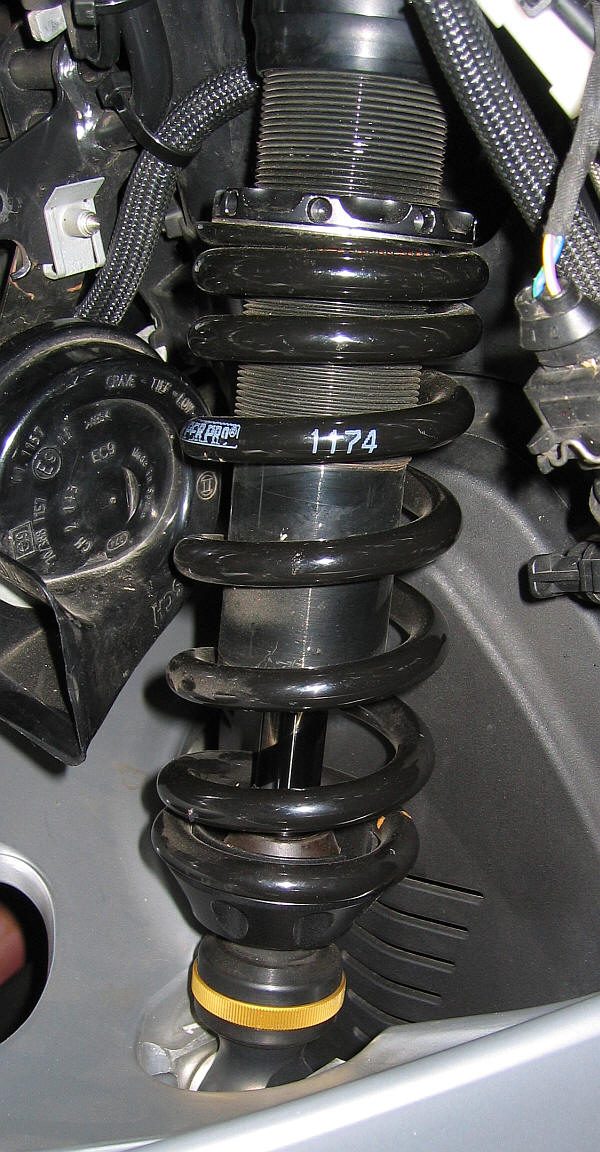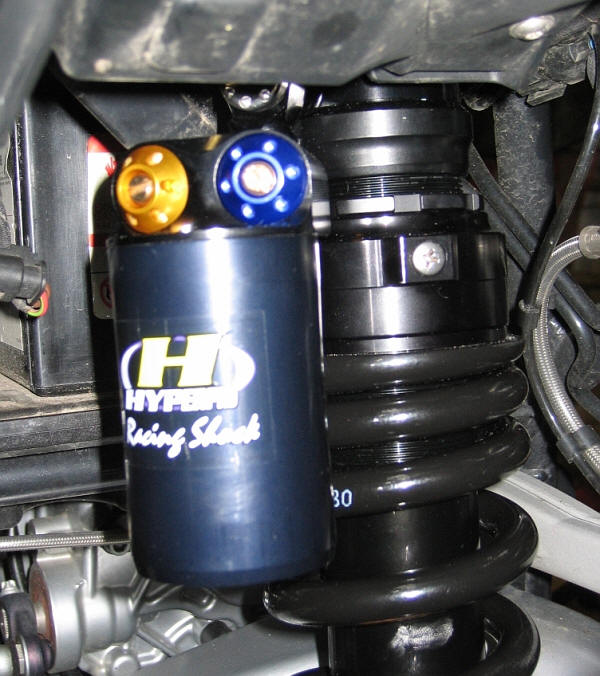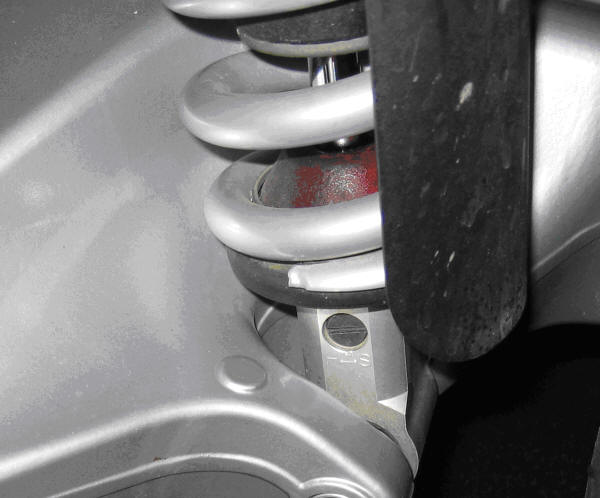Sag is pretty easy...
Preload is set with everything on the bike
that you'd normally ride with. If you ride
with saddlebags of rocks - you want the
saddlebags of rocks on the bike. You need to
take the measurements with the bike AS YOU
NORMALLY RIDE IT..
Measuring
REAR suspension static sag: This is
the height difference between the rear
suspension height fully extended, and the
rear suspension height with just the
weight of the bike (and whatever you
normally carry on it).
On the R12R - I found it
easy to measure using a tape measure hooked
in the hole in the rear axle to one of the
bag mounts. It's best if you're measuring at
a right angle to the surface of the earth..
horizontally (up-down). The usual technique
is to measure the bike on the centerstand
and make sure your rear wheel is off the
ground (no problem on mine..) then bounce
the bike off the centerstand, and having
someone help you hold it upright (without
putting any downward force on the bike) and
measure the same spots. Subtract the bigger
from the smaller and that's static sag. On
my Hyperpro's they call for 10mm +/- 5mm
static sag on a factory spec sheet that came
with the shocks.
There are some fancy techniques for getting
rid of stiction effects on the measurement
if you want to get fussy with it.. this is
done on the "on the wheels" measurement (it
doesn't make any difference on the unloaded
measurement).. that's to first take a
measurement after pushing down on the rear
and letting it rise on itself. Then you take
a second measurement after lifting the rear
and letting it settle by itself. You take
the average of the 2 numbers (A&B)/2=C as
your weighted distance. I wouldn't bother on
the roadster - I tried this and there was no
measureable difference (sign of a good low-stiction
suspension!)
Static sag is a good starting point IF the
manufacturer gives you the expected static
sag.
On my shocks, they came set from the factory
with too much static sag (too little
"preload") - the bike sat lower than it
should which caused it bottom and hit the
rubber bumper on the shaft too often,
kicking my butt out of my seat. Increasing
the preload in the rear decreased the sag -
and it no longer felt harsh. This seems
counterintuitive,
but
sometimes tightening up the spring will make
it feel softer. Go figure..
I also put
on a few pounds over the past few weeks, and
my butt was getting kicked again.. finally
dawned on me last night to up the preload a
few clicks, and my ride to work was
kick-free :-)
The more important measurement is
dynamic sag
- ie - the compression with your butt in the
seat.
With a linear (not progressively wound)
spring - the rule of thumb is 1/3rd the
total suspension travel = correct dynamic
sag. It's a rule of thumb making for a good
starting point.. some adjustment up/down is
probably going to be necessary, but it will
get you very close to where it should be.
NOTE - I
said "linear" spring. I got fooled on the
Hyperpro's which come with progressive wound
springs. A progressive wound spring starts
out soft and as it gets compressed gets
stiffer. A linear spring, provides linear
force throughout it's length (until the
coils start touching, aka "coil-bound"). It
turns out I needed more dynamic preload
(less sag) with the progressively wound
spring due to the non-linear
characteristics.. I found about 1/4 travel
dynamic preload to be workable for the
progressively wound springs.. What's
interesting - Hyperpro gives no dimension or
guide to dynamic, probably because of the
progressive nature of the springs. But
- I've digressed..
Measuring
your REAR suspension dynamic sag -
use the first measurement from your static
sag [A] - suspension fully extended, then plop
your butt on the bike, and just balancing it
on your tippie-toes with absolutely as
little force on your toes as possible - make
the loaded measurement [B].
Do the math (A-B)=C
and C is your dynamic sag.
BMW claims 140mm
travel on the stock rear suspension (I
calculated about 135mm - but they're
close..) That is IF the rubber bumper on the
shock were fully compressed and the shock
went metal to metal. Since that's not going
to happen, in reality - the rear has about
120mm of useable travel with the stock
suspension. You want the dynamic sag [C] to be
~1/3rd that number, or ~40mm (+/-5mm)
That's the rear - the
front is even easier to measure.. you just
need a tie-wrap.
Measuring your FRONT suspension static sag:
Put a small tie-wrap snuggly (not tight)
around the left fork leg above the slider.
Push it down onto the top of the slider-seal
so it's just touching. Take the bike gently
off the centerstand so it doesn't bounce.
The tie-wrap will move up as the suspension
compresses. Gently put it back on the
centerstand and make sure the front wheel is
"unloaded" (press down rear wheel until
front is off the ground.)
Measure between the bottom of the tie-wrap
and the top of the slider seal. That's your
static sag. If your shock manufacturer gave
you a measurement for this - it's a useful
thing to measure. If they didn't - it's
pretty much useless.
Measuring the FRONT dynamic sag:
To measure the dynamic sag, gently take it
off the centerstand, and gently put your
butt on the seat (no bouncing) - again
tippie-toe again. Gently get off and put it
on the centerstand. Repeat the measurement -
the difference between fully extended
measurement [A] and the measurement with
your butt in the seat [B] is your dynamic
(loaded) sag. (A-B)=C again. Usually the
dynamic and static sag aren't hugely
different on the front end of a Telelever
bike since the riders weight is primarily
carried on the rear wheel.
To find the
total travel of the front suspension
- just leave the tie wrap on and go for a
vigorous ride on a bumpy road. Put bike on
centerstand and repeat the measurement
between bottom of tie-wrap and top of fork
slider.
I didn't do this on the stock suspension
when I had it on - but I asked a friend to
on his.. he measured about 104mm (from
memory).. with my lowered suspension, I get
a total travel measurement of about 85mm
(the bike was lowered 20mm.. so it makes
sense.)
Once again you want your dynamic (loaded) sag
to be ~1/3rd the total travel - or around
35mm +/-5mm for stock suspension. (~1/4
travel for progressive wound springs..)
Do the same (A-B) = C.
That's where you start. If sag isn't set
correctly - nothing else will set correctly.

The threaded ring is
where you adjust front pre-load (sag) on
this Hyperpro aftermarket front shock



